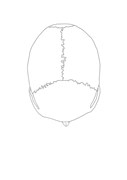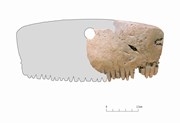
28 Feb 2023
Ancient comb carved from human skull reveals Iron Age practice unique to Cambridgeshire

- Archaeologists discovered the comb at an Iron Age site at Bar Hill near Cambridge
- This is an incredibly rare find with only two comparable examples ever found – both within the Cambridgeshire area
- The “Bar Hill Comb” gives us an incredible glimpse into a hyper-local tradition from more than 2000 years ago
An ancient bone comb carved from a fragment of human skull has been identified by archaeologists at Museum of London Archaeology (MOLA). This startling discovery was made as part of ongoing analysis on the more than 280,000 artefacts recovered by MOLA-Headland Infrastructure (MHI) as part of archaeological excavations on the National Highways A14 Cambridge to Huntingdon Improvement Scheme, which took place between 2016 and 2018.
Dating to the Iron Age (750 BC – 43 AD), the comb was unearthed at Bar Hill, 4 miles north-west of Cambridge. Although appearing to take the shape and form of a comb, the exact use of the object (dubbed the ‘Bar Hill Comb’) can only be theorised. However, this rare artefact shines new light on ritual and belief in Iron Age Britain, including how human remains were looked after and sometimes modified within local communities.
The re-use of human bone seems to have been a relatively common occurrence during Iron Age Britain. Objects made from human bone may have been used in special rituals relating to the dead, but others were part of everyday life. For example, other archaeological excavations in Cambridgeshire have uncovered tools for cleaning animal skins made from human leg and arm bones.
Combs made from animal bone were equally common, where they were used for textile work, as well as styling hair. However, MOLA Finds Team Lead, Michael Marshall, has only been able to identify two other examples of human bone combs ever discovered in Britain. Surprising, these were also found in Cambridgeshire, within 15 miles of Bar Hill. As Marshall speculates:
“It is possible this fascinating find represents a tradition carried out by Iron Age communities living solely in this area of Cambridgeshire. To be able to see such hyper-local influences in groups of people living over 2,000 years ago is truly astonishing.”
Curiously, there is no evidence of wear on the Bar Hill Comb’s teeth, suggesting it was never used as a functional item. Marshall theorises the answer to the use of this object may lie in a circular hole drilled into the comb, allowing it to be worn as an amulet. Across Britain there are many examples of pieces of human skull thought to have been worn as amulets. This connects to archaeological evidence across Iron Age Europe showing the collection, reuse, and display of human skulls – suggesting a widespread special significance to this portion of the human body. As Marshall explains:
“The Bar Hill Comb may have been a highly symbolic and powerful object for members of the local community. It is possible it was carved from the skull of an important member of Iron Age society, whose presence was in some way preserved and commemorated through their bones.”
Further analysis on the two incredibly similar pieces of worked human skull from Iron Age Cambridgeshire have also led Marshall to another fascinating possibility. Whilst the first example, unearthed at Earith in the 1970s, featured carved teeth, the second, found during excavations at Harston Mill in the early 2000s, only featured incised lines. Marshall suggests that if these objects were not meant for practical use as combs, perhaps the carvings were meant to represent the natural sutures that join sections of the human skull:
“These carved teeth and lines would have emphasised the Bar Hill Comb’s origin, at least amongst communities familiar with skeletal remains – as many in the Iron Age would have been. Rather than being an anonymous piece of bone, its symbolism and significance would therefore have been immediately apparent to anyone who encountered it.”
The Bar Hill Comb will now be kept at the Cambridgeshire Archaeology Archive, the main repository for material found as part of archaeological fieldwork in the county. Whilst its true function and significance may never be known, research on the more than 280,000 artefacts recovered as part of archaeological excavations on the National Highways A14 Cambridge to Huntingdon Improvement Scheme continue to reveal insights into the regions past. As Dr Steve Sherlock, Archaeology Lead for the A14 describes:
“This is a further example of the spectacular results from the excavations for the A14 improvements, adding detail and insight into our understanding of the human activity across Cambridgeshire and beyond.”
Contact Information
Museum of London Archaeology Media Office
media@mola.org.uk
Notes to editors
Notes to editors:
About the excavations on the A14:
The archaeology programme of the National Highways A14 Cambridge to Huntingdon improvement scheme took place over two years (2016-2018) and comprised over 40 separate excavations covering around 234 hectares. It revealed one of the richest archaeological landscapes in the UK, unearthing not only 280,947 artefacts but also plants, insects, animal, and human remains. Experts all over the country are now studying these materials to develop a more detailed picture of human occupation in Cambridgeshire across millennia.
More information about the project and discoveries can be found at www.molaheadland.com/a14.
About MOLA Headland Infrastructure:
Two of the most experienced archaeology and built-heritage practices in the UK, MOLA and Headland Archaeology, have combined their expertise to form MOLA Headland Infrastructure. The consortium has been formed specifically to deliver archaeological and heritage services to large, world-class infrastructure projects, that require large numbers of experts, programme certainty and a thorough understanding of the issues facing major construction programmes. Find out more at molaheadland.com
Timeline for the site:
- c. 800 BC: The Iron Age begins (so called because Iron replaced Bronze as the main raw material for tools and weapons)
- c. 400 - 100 BC: (Middle Iron Age), a small settlement is established at Bar Hill, the Bar Hill Comb is made.
- AD 43: The Romans invade Britain, led by Emperor Claudius. End of the Iron Age.
- c. AD 70: Settlement activity at Bar Hill ends.
About MOLA
MOLA is an experienced and innovative archaeological and built heritage practice, Independent Research Organisation, and charity. With over 350 staff working across England, MOLA has been providing independent, professional heritage advice and services for over 50 years. Find out more at mola.org.uk, on Twitter, Facebook and LinkedIn.








